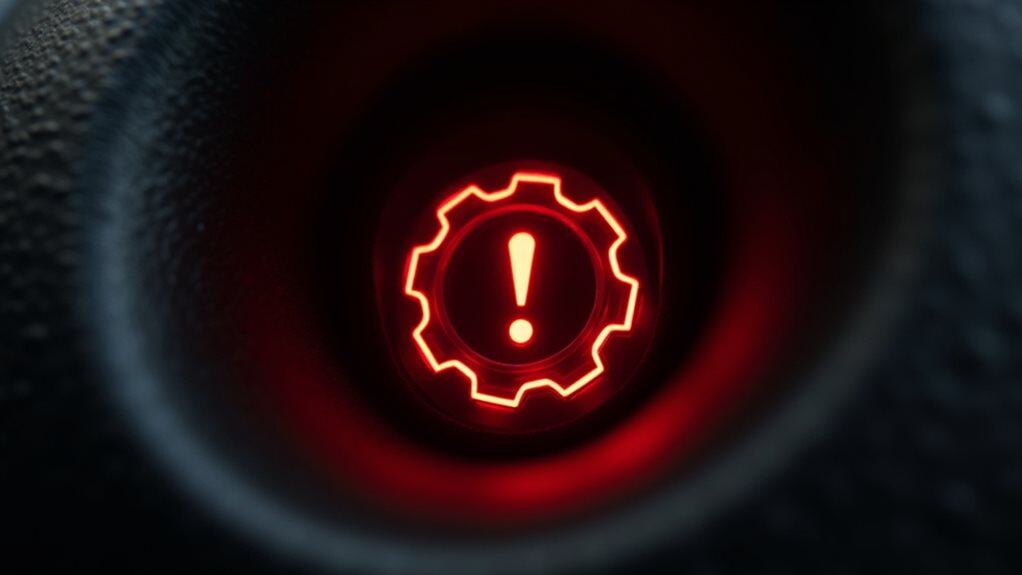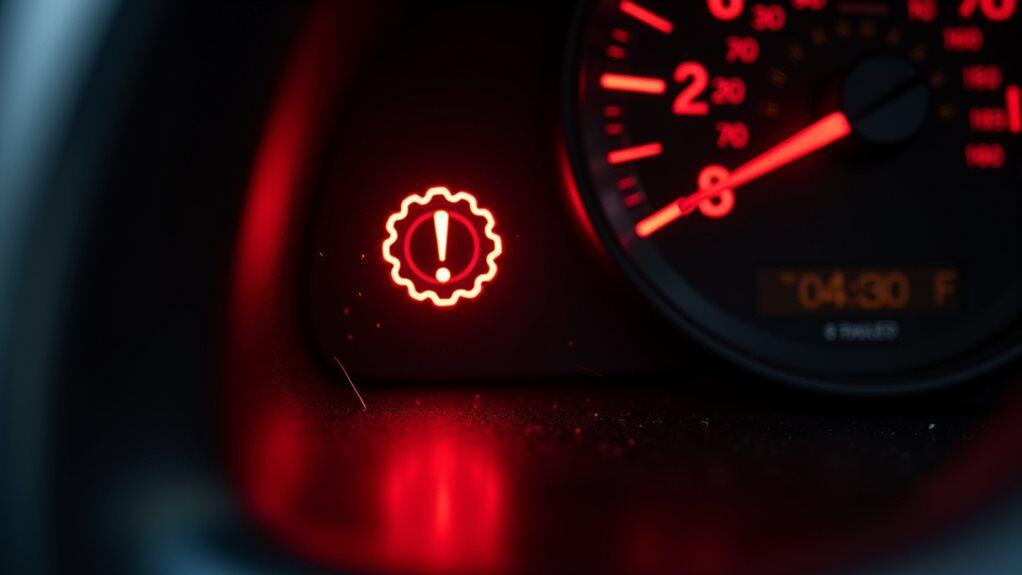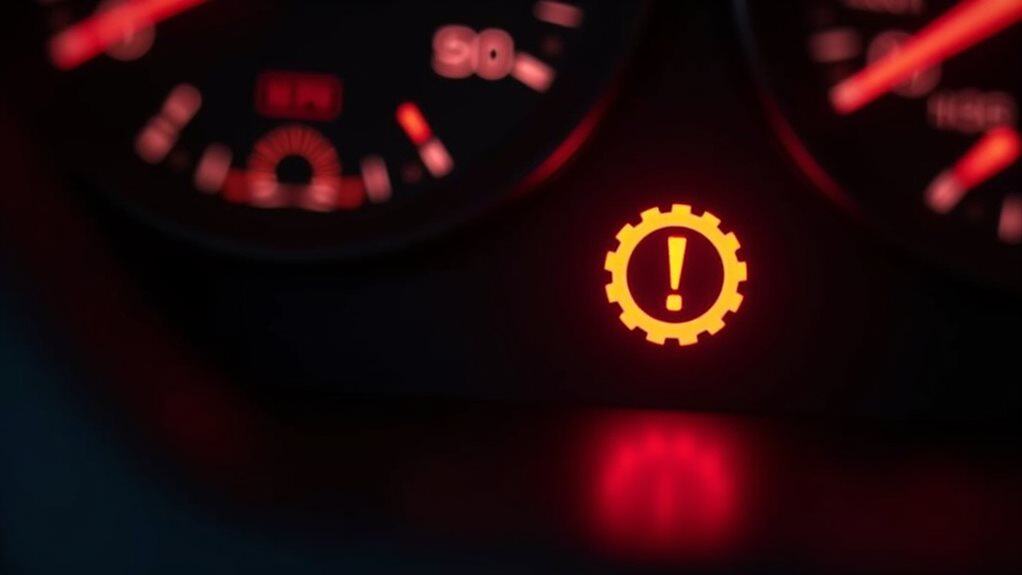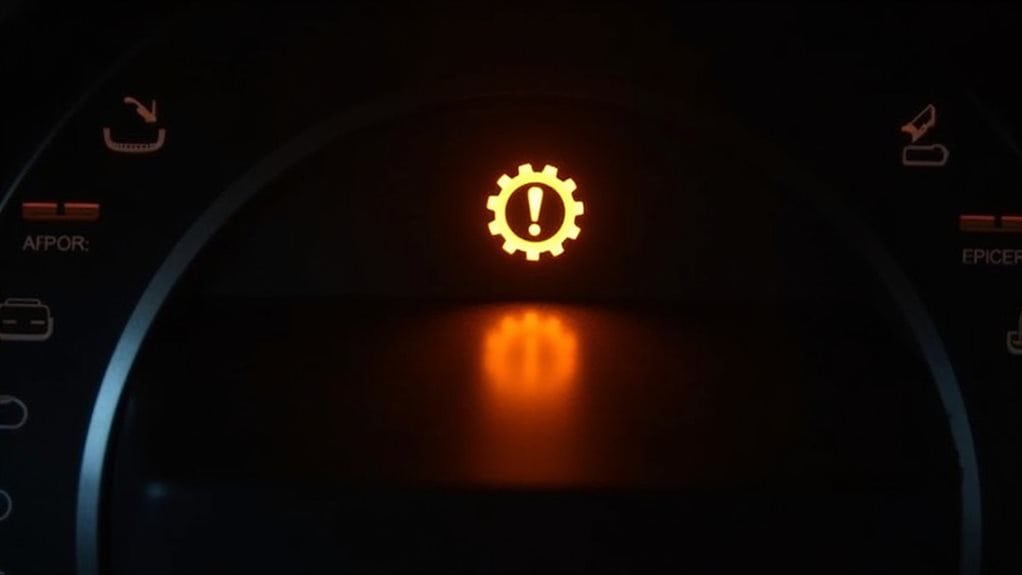Your transmission warning light, typically appearing as a gear with an exclamation mark or thermometer icon, indicates potential transmission system issues that need immediate attention. Low fluid levels, overheating, or internal component failures commonly trigger this warning. When you see this light, safely pull over, check your owner’s manual, and inspect for unusual noises or fluid leaks. Taking quick action can prevent costly repairs, while understanding the specific causes will help you maintain your vehicle’s health.
Quick Tips
- The transmission warning light appears as a gear symbol with an exclamation mark or thermometer, indicating potential transmission system problems.
- Low transmission fluid levels or fluid leaks commonly trigger the warning light, requiring immediate inspection to prevent damage.
- When the warning light appears, safely pull over and check for unusual noises, vibrations, or visible fluid leaks.
- Overheating transmission fluid is a frequent cause, indicated by the warning light and possibly accompanied by smoke.
- Ignoring the transmission warning light can lead to complete transmission failure and expensive repairs or replacement costs.
Understanding the Transmission Warning Light Symbol

Dashboard indicators serve as your vehicle’s primary communication system, and among these important signals, the transmission warning light demands particular attention.
You’ll typically see this warning as a gear symbol with an exclamation mark or a thermometer icon, though its appearance can vary by vehicle model. Low transmission fluid can lead to the activation of this warning light, indicating potential issues within the transmission system.
When it illuminates, you should consult your owner’s manual for specific meaning and proper response. Ignoring these warning lights can result in expensive repair costs if transmission problems are left unaddressed.
Common Triggers That Illuminate Your Warning Light
Your transmission warning light can illuminate due to several critical issues, with overheating being one of the most common triggers when your transmission fluid temperature rises too high. Low transmission fluid levels, often caused by leaks, will trigger the warning light while also putting your transmission at risk of severe damage. The appearance of smoke under the hood is a serious sign that requires immediate inspection, as it may indicate a failing seal that leads to fluid loss. Internal component failures, such as worn planetary gears or malfunctioning solenoids, can also activate the warning light and require immediate professional attention.
Overheating Transmission Warning Signs
When a transmission begins overheating, several distinct warning signs typically emerge to alert drivers of potential problems.
You’ll notice a burning smell from degrading fluid, along with gears that slip or shift with delay.
Your vehicle might shake or produce grinding sensations while driving.
In modern cars, dashboard warning lights will illuminate to indicate dangerous transmission temperatures.
Low Fluid Level Problems
Among the most common causes of transmission warning lights, low fluid levels stand at the forefront of potential problems.
You’ll notice several warning signs: delayed gear engagement, slipping gears, and a burning smell.
Check under your vehicle for telltale fluid puddles, which often result from worn seals, cracked transmission pans, or loose bolts.
Don’t ignore these symptoms, as they can lead to serious transmission damage.
Internal Component Failure Issues
Internal component failures represent one of the most serious triggers for transmission warning lights, often indicating problems that require immediate attention.
When you notice erratic shifting or unusual noises, your transmission’s planetary gear sets, clutch packs, or bearings might be failing.
Overheating and excessive towing can strain these components, leading to damage that’ll require specialized repair tools and expert knowledge.
Immediate Steps When Your Warning Light Appears
Seeing a transmission warning light illuminate on your dashboard requires immediate attention and careful response.
First, safely pull over to prevent potential damage. Check your owner’s manual to identify the specific warning symbol, and look for unusual noises or vibrations.
Once stopped, inspect for visible fluid leaks and note any performance changes you’ve experienced to help with diagnosis. Additionally, ensure transmission fluid levels are adequate, as low levels can lead to serious transmission issues.
Potential Risks of Ignoring the Warning Light

When you disregard a transmission warning light, you’re taking significant risks that can lead to severe consequences for your vehicle and safety.
You’ll likely experience reduced power transfer, erratic shifting, and poor fuel efficiency.
What might start as minor issues can quickly escalate into complete transmission failure, leaving you stranded and facing costly repairs or replacement. Additionally, regular maintenance schedules can help identify issues before they become critical and prevent further damage to your vehicle.
Essential Maintenance to Prevent Warning Light Issues
To maintain a healthy transmission and prevent warning light issues, you’ll need to establish a consistent maintenance routine that addresses multiple components of your vehicle’s transmission system.
Regular fluid checks, timely filter replacements, and monitoring transmission coolers are essential steps.
You should also inspect belts, hoses, and watch for unusual noises or vibrations that could indicate developing problems.
Professional Diagnostic Methods and Solutions

Although drivers might be tempted to diagnose transmission issues themselves, professional diagnostic methods offer the most accurate and detailed approach to identifying warning light problems.
Professional mechanics use advanced OBD-II scanners to read trouble codes and perform extensive system tests. You’ll benefit from their knowledge in interpreting diagnostic results and implementing appropriate repairs before minor issues become major expenses.
Safety Tips for Driving With an Active Warning Light
Since your safety is paramount while operating a vehicle, understanding how to respond to an active transmission warning light can help prevent dangerous situations and costly repairs.
If you notice the warning light, safely pull over as soon as possible to let your transmission cool down. Don’t continue driving, as this can lead to complete transmission failure.
If necessary, have your vehicle towed to avoid further damage.
Wrapping Up
When your transmission warning light illuminates, you’ll now know exactly what steps to take and why they’re essential for your vehicle’s health. Don’t ignore this important indicator, as it’s your car’s way of alerting you to potentially serious issues. Regular maintenance, prompt attention to warning signs, and professional diagnostics when needed will help keep your transmission running smoothly and prevent costly repairs down the road.

